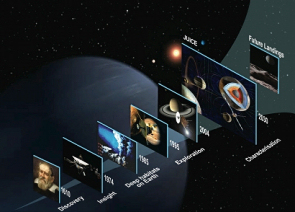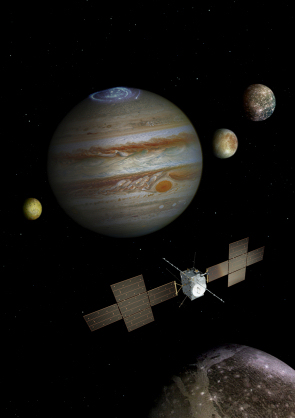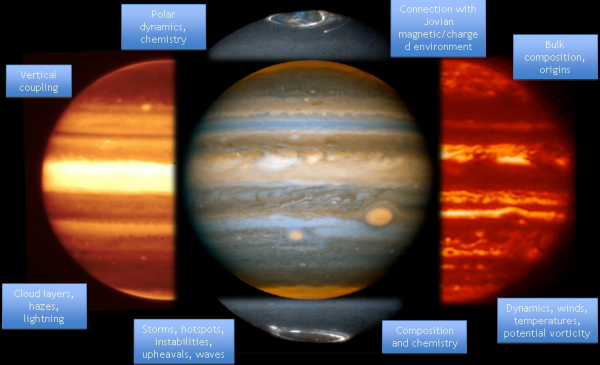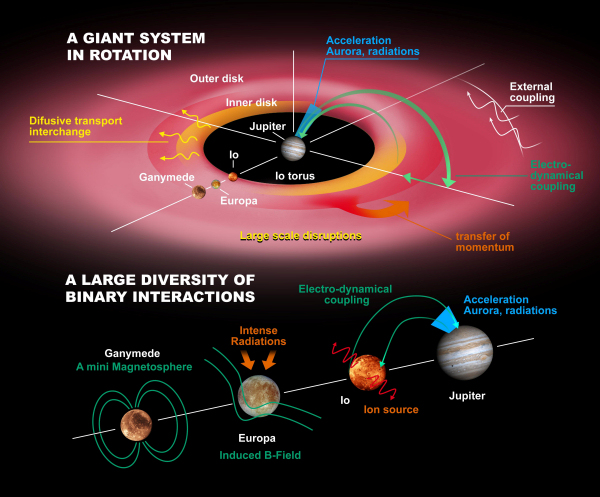Science Objectives
The JUpiter ICy moons Explorer (JUICE) will perform detailed investigations of Jupiter and its system in all their inter-relations and complexity with particular emphasis on Ganymede as a planetary body and potential habitat. Investigations of Europa and Callisto would complete a comparative picture of the Galilean moons.
 |
| A road of exploration: from discovery of the Jovian moons by Galileo to in-situ investigations by JUICE. Credit: ESA |
Jupiter is the archetype for the giant planets of the Solar System and for the numerous giant planets now known to orbit other stars. Moreover, Jupiter's diverse Galilean satellites - three of which are believed to harbour internal oceans - are central to understanding the habitability of icy worlds.
Understanding the Jovian system and unravelling its history, from its origin to the possible emergence of habitable environments, will give us a better insight into how gas giant planets and their satellites form and evolve. In addition, new light should be shed on the potential for the emergence of life in Jupiter-like exoplanetary systems.
The JUICE mission will address two themes of ESA's Cosmic Vision programme: What are the conditions for planet formation and emergence of life? and How does the Solar System work?
Internal oceans - habitable worlds?
 |
| Artist's impression of the JUICE spacecraft inthe Jovian system. The illustration shows Jupiter and its large moons: Ganymede, Europa, Io and Callisto. |
The focus of JUICE is to characterise the conditions that may have led to the emergence of habitable environments among the Jovian icy satellites, with special emphasis on the three ocean-bearing worlds, Ganymede, Europa, and Callisto. Ganymede is identified for detailed investigation since it provides a natural laboratory for analysis of the nature, evolution and potential habitability of icy worlds in general, but also because of the role it plays within the system of Galilean satellites, and its unique magnetic and plasma interactions with the surrounding Jovian environment.
The main science objectives for Ganymede, and to a lesser extent for Callisto, are:
- characterisation of the ocean layers and detection of putative subsurface water reservoirs;
- topographical, geological and compositional mapping of the surface;
- study of the physical properties of the icy crusts;
- characterisation of the internal mass distribution, dynamics and evolution of the interiors;
- investigation of the exosphere;
- study of Ganymede's intrinsic magnetic field and its interactions with the Jovian magnetosphere.
Jupiter system as an archetype for gas giants
The mission will also focus on characterising the diversity of processes in the Jupiter system which may be required in order to provide a stable environment at Ganymede, Europa and Callisto on geologic time scales.
The studies of the Jovian atmosphere will be focused on investigation of its structure, dynamics and composition. The circulation, meteorology, chemistry and structure of Jupiter will be studied from the cloud tops to the thermosphere. These observations will be attained over a sufficiently long temporal baseline with broad latitudinal coverage to investigate evolving weather systems and the mechanisms of transporting energy, momentum and material between the different layers.
 |
| JUICE science objectives at the Jovian atmosphere. Credit: ESA |
The focus in the Jovian magnetosphere will include an investigation of the three-dimensional properties of the magnetodisc and in-depth study of the coupling processes within the magnetosphere, ionosphere and thermosphere. Aurora and radio emissions and their response to the solar wind will be elucidated.
Within Jupiter's satellite system, JUICE will also study the moons' interactions with the magnetosphere, gravitational coupling and long-term tidal evolution of the Galilean satellites.
 |
| Complex interactions within the Jovian system will be in the focus of the JUICE investigations. Credit: ESA |
(For more detailed information about the science objectives of JUICE, please consult the JUICE assessment study report (Yellow Book) - see link in right-hand menu.)

